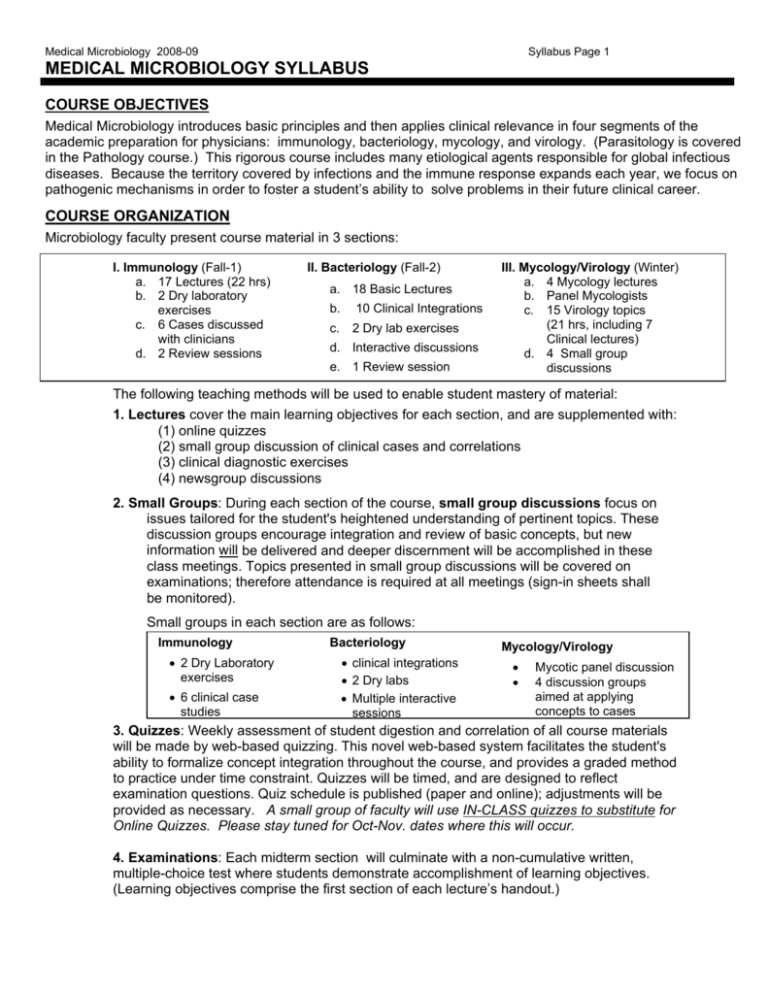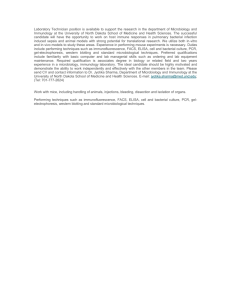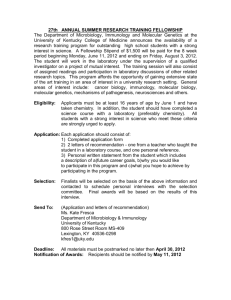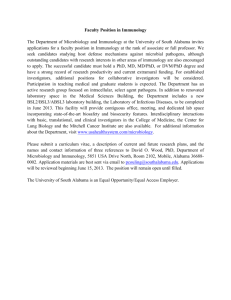medical microbiology syllabus
advertisement

Medical Microbiology 2008-09 Syllabus Page 1 MEDICAL MICROBIOLOGY SYLLABUS COURSE OBJECTIVES Medical Microbiology introduces basic principles and then applies clinical relevance in four segments of the academic preparation for physicians: immunology, bacteriology, mycology, and virology. (Parasitology is covered in the Pathology course.) This rigorous course includes many etiological agents responsible for global infectious diseases. Because the territory covered by infections and the immune response expands each year, we focus on pathogenic mechanisms in order to foster a student’s ability to solve problems in their future clinical career. COURSE ORGANIZATION Microbiology faculty present course material in 3 sections: I. Immunology (Fall-1) a. 17 Lectures (22 hrs) b. 2 Dry laboratory exercises c. 6 Cases discussed with clinicians d. 2 Review sessions II. Bacteriology (Fall-2) a. 18 Basic Lectures b. 10 Clinical Integrations c. 2 Dry lab exercises d. Interactive discussions e. 1 Review session III. Mycology/Virology (Winter) a. 4 Mycology lectures b. Panel Mycologists c. 15 Virology topics (21 hrs, including 7 Clinical lectures) d. 4 Small group discussions The following teaching methods will be used to enable student mastery of material: 1. Lectures cover the main learning objectives for each section, and are supplemented with: (1) online quizzes (2) small group discussion of clinical cases and correlations (3) clinical diagnostic exercises (4) newsgroup discussions 2. Small Groups: During each section of the course, small group discussions focus on issues tailored for the student's heightened understanding of pertinent topics. These discussion groups encourage integration and review of basic concepts, but new information will be delivered and deeper discernment will be accomplished in these class meetings. Topics presented in small group discussions will be covered on examinations; therefore attendance is required at all meetings (sign-in sheets shall be monitored). Small groups in each section are as follows: Immunology • 2 Dry Laboratory exercises • 6 clinical case studies Bacteriology • clinical integrations • 2 Dry labs • Multiple interactive sessions Mycology/Virology • • Mycotic panel discussion 4 discussion groups aimed at applying concepts to cases 3. Quizzes: Weekly assessment of student digestion and correlation of all course materials will be made by web-based quizzing. This novel web-based system facilitates the student's ability to formalize concept integration throughout the course, and provides a graded method to practice under time constraint. Quizzes will be timed, and are designed to reflect examination questions. Quiz schedule is published (paper and online); adjustments will be provided as necessary. A small group of faculty will use IN-CLASS quizzes to substitute for Online Quizzes. Please stay tuned for Oct-Nov. dates where this will occur. 4. Examinations: Each midterm section will culminate with a non-cumulative written, multiple-choice test where students demonstrate accomplishment of learning objectives. (Learning objectives comprise the first section of each lecture’s handout.) Medical Microbiology 2008-09 Syllabus Page 2 ASSESSMENT Student performance in Medical Microbiology will be evaluated by a series of exams and quizzes. Attendance at all course events is necessary for optimal performance, and material presented in small group sessions will be graded and shall be included in quizzes and exams. In light of pod-casting, students are reminded that confusion in lecture is most efficiently cleared up immediately by questions in lecture rather than at later times. Grades are not determined for individual exams. Final grades are determined according to the ratios in the following table. Examinations Quizzes Number 3 20 % each 30% 0.5% Total % of Final Grade 90% 10% Following grade determination, teaching faculty from the Department of Microbiology meet to set the Pass-Fail line at two standard deviations from the mean score. REQUIRED TEXTBOOKS: Preparing prior to class will be the single most effective mechanism to ensure success in Medical Microbiology Reading assigned chapters in the textbook will logarithmically increase a student’s knowledge and will heighten both complete understanding and efficient mastery of required material. Immunology: Peter Parham, The Immune System, 2nd ed. (New York: Current Trends/Garland, 2005). Bacteriology / Mycology / Virology: Patrick R. Murray, Ken S. Rosenthal, Michael A. Pfaller. Medical Microbiology, 5th ed. (Philadelphia: Elsevier/Mosby, 2005). RECOMMENDED STUDY BOOKS: Levinson, W. Review of Medical Microbiology and Immunology, SERIES (NY: McGraw-Hill, 2006). 9th ed. LANGE REVIEW Harvey, R.A., P.C.Champe, and B.D. Fisher. Microbiology, 2nd edition. LIPPINCOTT’S ILLUSTRATED REVIEWS (Philadelphia: Lippincott, Williams, & Wilkins, 2007). Medical Microbiology 2008-09 Syllabus Page 3 PROFESSIONALISM OBJECTIVES: The Department of Microbiology endeavors to prepare candidates for the Doctor of Medicine degree with the following professional objectives for their successful career. A student’s desire to practice these objectives in Medical Microbiology (and other undergraduate medical education) will substantially enhance their knowledge, humility, and technical skill for a successful and rewarding career. 1. Demonstrate respect for others a. Students are asked to attend all class meetings, particularly small group exercises. b. Students respond in dignified manner to faculty, staff, and student colleagues, exemplifying their maturity and empathy. c. Students agree to abide by appropriate biosafety practices when in BSL-2 exercises. 2. Exhibit honesty and integrity a. Students abide by the Honor Code of the University of Virginia in all exams, quizzes, and graded assignments. b. Students discuss honestly any grading oversights or computer/technology errors with Course faculty as soon as discrepancies arise. 3. Practice concern through communication, respect, and understanding a. Students grasp opportunities to “rehearse” professional etiquette when dealing with faculty in situations of uncertainty and/or ignorance. b. Students appreciate the enormous benefits of faculty variation in education and/or background by seeking to understand diverse populations. c. Students encourage their classmates to heightened levels of understanding by promoting questions and through the support of shared personal experiences. 4. Perform assignments responsibly and with accountability a. Students complete open-book, online quizzes each week, according to the Section schedule. b. Students arrive promptly to classes as well as small groups activities. c. Students work effectively as a team member when assigned, realizing they gain more when fully engaged. d. Students seize the opportunity to learn from a diverse group of faculty instructors in small group settings, focused on basic relevance of clinical cases. 5. Seek excellence and scholarship a. Students strive to excel at all four areas of Medical Microbiology, including immunology, bacteriology, mycology, and virology. b. Students read to supplement the foundational scaffold of information presented in lecture. c. Students seek to develop treatment behaviors that will reduce the incidence of antimicrobial resistance in the world. Medical Microbiology 2008-09 Syllabus Page 4 OTHER RESOURCES FOR STUDENT SUCCESS IN MEDICAL MICROBIOLOGY Web: The course website (http://www.med-ed.virginia.edu/courses/micro/index.cfm ) contains necessary information for successful completion of this course, including links to the following: lecture notes, weekly quizzes, tutorials, practice exams, and laboratory/small group information. The website will be updated throughout the course as new resources are necessary, and is considered to be the most up-to-date reference for the course. Review Core course material from First Year: • Basic Biology o The Online Biology Book: http://www.emc.maricopa.edu/faculty/farabee/BIOBK/BioBookTOC.html • Cell Biology: o The Virtual Cell http://www.ibiblio.org/virtualcell/tour/cell/cell.htm o The Open Directory Project – Cell biology chapter http://dmoz.org/Science/Biology/Cell_Biology/ o The Biology Project (U. Arizona) http://www.biology.arizona.edu/cell_bio/cell_bio.html • Biochemistry o The Dictionary of Cell and Molecular Biology http://www.mblab.gla.ac.uk/dictionary/ • Genetics o DNA from the beginning: http://www.dnaftb.org/dnaftb/ • Immunology o The Biology Project (U. Arizona) http://www.biology.arizona.edu/immunology/immunology.html o Keratin.com http://www.keratin.com/am/ Newsgroup: Answers to common conceptual questions are posted to the course newsgroup by fellow students and Microbiology faculty. In addition, students may submit questions by email (medmicrocourse@virginia.edu ), and faculty will supply responses via the course newsgroup. The Newsgroup is also the first place to check when reviewing for exams, as lecture clarifications (and error corrections) will be made public on the Newsgroup first. Questions shall be addressed as “conversations” and a topic can have many entries to allow complete understanding of that topic. Students can reach the Newsgroup through our course website (address above). Remember, the most efficient way to have questions answered is to ask them in class! Delays often occur for email-submitted queries. Email: Class meeting modifications, room changes, and schedule emergencies will be emailed directly to students. To avoid extensive crowding of student email accounts, all general course content questions and clarifications will be posted to the course Newsgroup (see above). BUGS/POPS: These medical microbiology tutorials with case studies will be available for self-paced learning throughout the semester. Students are encouraged to use BUGS, POPS, and the other tutorials early in the course (particularly during the Immunology section) to facilitate familiarity with infectious organisms prior to the large amount of information presented in Virology, Mycology, and Bacteriology. Microbes in Motion II: is an interactive electronic textbook with animations and quiz questions. Intended primarily as a tutorial for the Bacteriology section of the course, there are also chapters on Immunology and Virology that you may find helpful. This software is available on all Health System Library computers.





